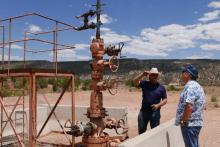Neometals Ltd has struck gold in the archives, uncovering a cache of 2271 unreported historic drill assays from its Barrambie gold project in Western Australia’s goldfields, including a bonanza 3-metre run at 95.7 grams per tonne gold. The discovery will guide an upcoming drilling program. Neometals is set to get the drill rod spinning before the end of the year.


Neometals Limited has struck gold in the archives, uncovering a cache of 2271 unreported historic drill assays at its Barrambie gold project in Western Australia’s goldfields, including a bonanza 3-metre run at 95.7 grams per tonne (g/t) gold.
Other notable intercepts include 17m averaging 6.5g/t gold from 23 m, with 7m at 11.35 g/t, and a thick 32m kicking in at 2.21 g/t from 18m, with a 3m high-grade core of 8.72 g/t.
In total, the historic dataset includes assays from 61 reverse circulation holes drilled in 1987 and 1988 at the project’s Ironclad deposit. Most of the holes ended at 51m depth, with the deepest extending to only 90m – leaving significant potential open at depth.
While the results are yet to be verified, Neometals says the additional data will guide future mineral resource updates and its resource exploration drilling programs.
First, let’s roll the clock back.
About the time the historic holes were being drilled, the gold price surged from about US$402 (A$624) per ounce to US$502 (A$780) per ounce as investors fled to safety during the October 1987 ‘Black Monday’ stock market crash. A weaker United States dollar, inflation, rising interest rates, heightened Cold War tensions and Middle East risks added fuel to the rally, cementing gold’s reputation as a safe-haven asset.
The price of the precious yellow metal retreated through 1988 to a low of US$389 (A$603) an ounce, slipping from its 1987 highs as markets stabilised. A stronger US dollar and easing geopolitical tensions removed much of gold’s crisis premium, leaving it trading largely in the low US$400s.
The short-lived gold spike ignited WA’s second gold boom, driving record exploration spending and a frenzy of drilling across the state’s greenstone belts. But as gold drifted lower from its 1987 highs, risk capital evaporated and exploration spending slumped, bottoming out during the early-1990s recession.
Fast forward to today, and gold is on another tear, punching through a record US$3698 (A$5538) an ounce in yesterday’s trade. The rally is being fuelled by mounting geopolitical tensions, growing concerns over the US economy and surging central bank demand for the precious metal.
That’s all good news for Neometals, which is picking up where the last generation of explorers left off. With little modern exploration conducted across its 505-square-kilometre Barrambie tenure since the 1990s, the newly uncovered historic assays provide a valuable springboard for it to target and grow the project’s gold potential.
Neometals Limited managing director Chris Reed said: “The analysis and inclusion of this additional historical data is expected to aid the progression of the Ironclad deposit towards production and mining. We’re progressing related studies in parallel with planning the next phase of drilling and are also excited to commence our first drilling next month at the historic high-grade Barrambie Ranges mine, which is the first cab off the rank in terms of our broader project exploration strategy.”
Barrambie is Neometal’s jewel in the crown – though initially for very different reasons. The project is on one of the largest vandiferous-titanomagnetite resources globally, featuring 280.1 million tonnes at 9.18 per cent titanium oxide and 0.44 per cent vanadium pentoxide.
Gold was discovered at Barrambie in 1905 during the construction of the Rabbit-Proof Fence. Four main gold centres were established in the area, two of which fall within Neometal’s tenure. Together, the centres produced 27,294 ounces of gold from 34,233 tonnes of treated ore at an impressive 24.8 g/t gold.
Building on this legacy, Neometals has etched out an exploration target of 8 million to 10.5 million tonnes grading between 1.3g/t and 2.3g/t for a possible 335,000 to 775,000 ounces of contained gold.
The company’s maiden drilling program at the project earlier this year returned a slew of high-grade hits, headlined by 6.2m at 9.87g/t gold from 30.8m, including 3m at 19.78g/t.
Bouyed by record gold price and with its foot firmly planted on a prime patch of WA’s goldfields, Neometals has pivoted to aggressively advance Barrambie’s golden potential – with the drill bit poised to unlock the next chapter in this historic mining district.
Is your ASX-listed company doing something interesting? Contact: matt.birney@businessnews.com.au












